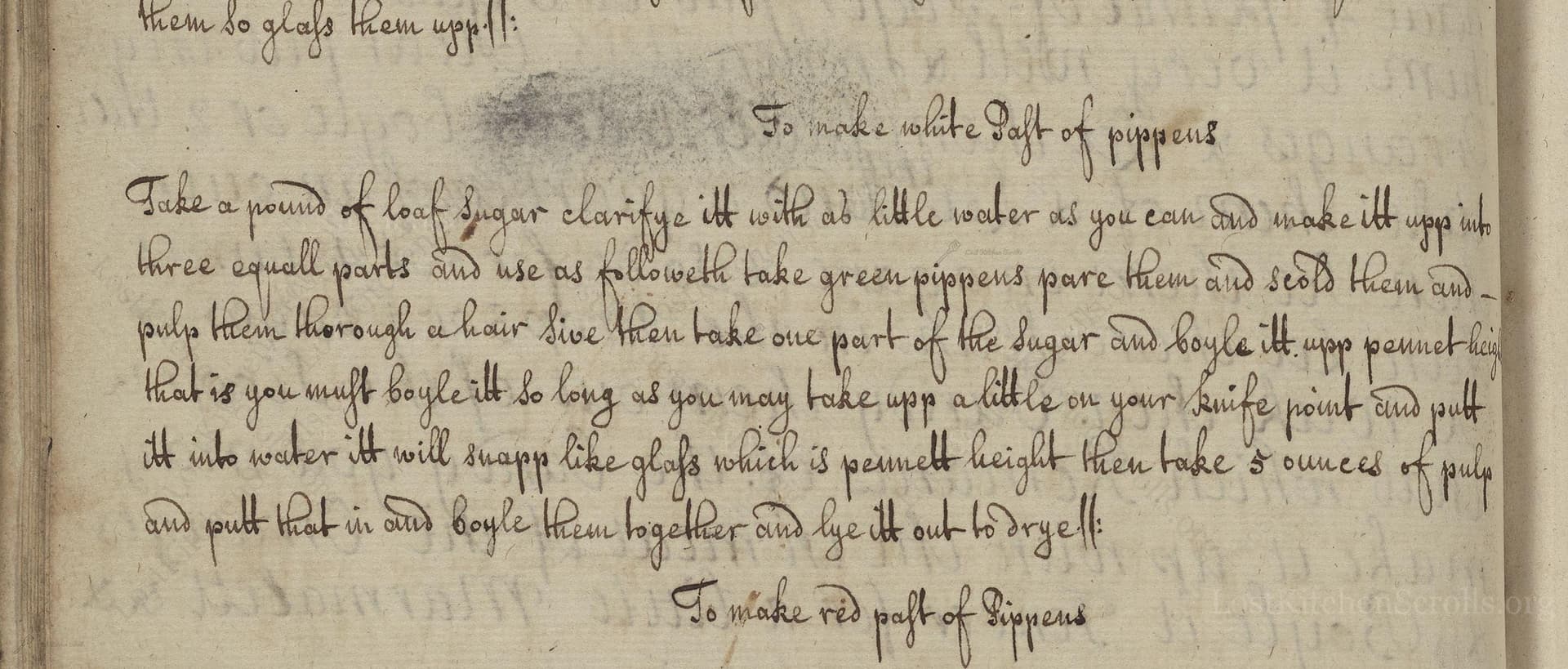To Make White Past Of Pippens
From the treasured pages of Mrs. Rachel Kirk Book 1707
Written by Rachel Kirk

To Make White Past Of Pippens
"Take a pound of loaf sugar clarifie itt with as little water as you can and make itt upp into three equall parts and use as followeth take green pippens pare them and scold them and pulp them thorough a hair sive then to one pound of the pulp take one part of the Sugar and boyle itt upp pennet height that is you must boyle itt so long as till you take upp a little on your knife point and putt itt into water itt will snapp like glass which is pennet height then take 5 ounces of pulp and putt that in and boyle them both together and lye itt out to drye."
Note on the Original Text
The recipe is written in the instructive style of the early 1700s, assuming the reader already knows basic confectionery techniques. Terms like 'clarifie' mean to dissolve and purify the sugar. 'Pennet height' refers to the hard crack stage of sugar—which modern confectioners monitor with a thermometer but was tested then by dropping syrup in water to see if it 'snaps like glass.' Spelling is variable by modern standards, and sentence structure is continuous, showing how recipes—even for sweets—relied on a reader’s familiarity with processes and judgment in kitchen craft.

Title
Mrs. Rachel Kirk Book 1707 (1707)
You can also click the book image above to peruse the original tome
Writer
Rachel Kirk
Era
1707
Publisher
Unknown
Background
A remarkable collection of early 18th-century recipes, Rachel Kirk's work invites readers into the kitchens of the past where classic culinary traditions and timeless flavors come alive. Expect a charming medley of savory feasts and sweet treats reflective of the era's sophisticated palate.
Kindly made available by
Folger Shakespeare Library
This recipe, originally penned by Rachel Kirk in 1707, reflects the early modern English fascination with fruit confections. Apples—specifically green 'pippens,' a term for several tart English apple varieties—were readily available and prized for their sharpness, making them ideal for preserves and sweet pastes. White pastes such as this were often made in genteel households, both as a method of preserving fruit and for their decorative and gustatory appeal in banqueting courses, a tradition of sweetmeat presentation popular among the English elite.

In the early 18th century, cooks would have used a brass sugar pan or skillet over an open hearth or a charcoal chafing dish to boil sugar. Clarification would be done with skimming spoons and perhaps a jelly bag. Apples would be pressed through a horsehair sieve, and drying would be on sheets or wooden boards in a cool, airy place. For us today, a heavy-bottomed saucepan, fine mesh sieve, and a candy thermometer (to check 'penet height'/hard crack stage) replace these older tools. Non-stick parchment paper or silicone sheets help with modern drying, offering a convenient update on the wooden trays or oiled papers used historically.
Prep Time
20 mins
Cook Time
40 mins
Servings
24
We've done our best to adapt this historical recipe for modern kitchens, but some details may still need refinement. We warmly welcome feedback from fellow cooks and culinary historians — your insights support the entire community!
Ingredients
- 1 lb white caster sugar
- 3 tbsp water
- 6–8 green apples (about 2–2.2 lb, e.g., Granny Smith as substitute for pippins)
- Extra apple purée as needed (about 5 oz for each batch)
- Parchment paper (for drying)
Instructions
- Begin by preparing a sugar syrup: take 1 pound of white caster sugar and dissolve it in as little water as possible (about 3 tablespoons).
- Bring to a boil and skim if needed to clarify.
- Divide the syrup into three equal parts and set aside.
- Peel, core, and roughly chop about 6–8 green apples (ideally tart varieties like Granny Smith as a substitute for 'pippins').
- Blanch the apple peices briefly in boiling water, then push them through a fine mesh sieve to make a smooth apple purée.
- For each batch: Take 1 pound of apple purée and mix it with one part (about 5 ounces) of the sugar syrup.
- Boil this mixture until it reaches what we now call 'hard crack stage' (302°F), or until a dollop dropped in cold water snaps like glass.
- Then, add an additional 5 ounces (about 140 grams) of fresh apple purée, mix, and boil again breifly until blended through.
- Spread the mixture onto a parchment-lined tray in a thin layer and leave to dry at room temperature for several hours or overnight until firm and set.
Estimated Calories
60 per serving
Cooking Estimates
You will need around 20 minutes to prepare the apples and syrup before cooking. Cooking takes about 40 minutes total, including boiling the apple purée and syrup. Expect to get about 24 pieces, each with roughly 60 calories.
As noted above, we have made our best effort to translate and adapt this historical recipe for modern kitchens, taking into account ingredients nowadays, cooking techniques, measurements, and so on. However, historical recipes often contain assumptions that require interpretation.
We'd love for anyone to help improve these adaptations. Community contributions are highly welcome. If you have suggestions, corrections, or cooking tips based on your experience with this recipe, please share them below.
Join the Discussion
Rate This Recipe
Dietary Preference
Main Ingredients

Den Bockfisch In Einer Fleisch Suppen Zu Kochen
This recipe hails from a German manuscript cookbook compiled in 1696, a time whe...

Die Grieß Nudlen Zumachen
This recipe comes from a rather mysterious manuscript cookbook, penned anonymous...

Ein Boudain
This recipe comes from an anonymous German-language manuscript cookbook from 169...

Ein Gesaltzen Citroni
This recipe, dating from 1696, comes from an extensive anonymous German cookbook...
Browse our complete collection of time-honored recipes



